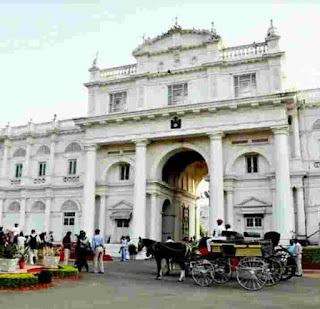 |
| chandeliers-largest pair in the world''Jai Vilas Palace,Gwalior Indiawikimedia.org/ |
 |
| Jai Vilas Palace, Gwalior. India .livehistoryindia.com/living-history/forgotten-treasures |
 |
| Jai Vilas palace, Gwalior, dinning table with model train track.alamy.com |
 |
| Jai Vilas Palace, Gwalior. India livehistoryindia.com |
 |
| Maharajah Jayajirao Scindia of Gwalior. .theindianportrait.com |
Above image: Sir Shrimant Jayajirao Scindia (19 January 1834-20 June 1886) of the Scindia dynasty of the Maratha clan was the ruling Maharajah of Gwalior from 1843 to 1886 under the British rule. keenly interested in the welfare of his state, in 1872, Sri Jayajirao gave Rs. 7.5 million for building the Agra-Gwalior portion of the Great Indian Peninsular Railway, and a similar amount in 1873 for the Indore-Neemuch section of the Rajputana-Malwa railway. In 1882 land was ceded by the state for the Midland section of the Great Indian Peninsular Railway.
Shrimant Jayaajirao was a great builder and constructed many impressive buildings like Moti Mahal, Jai Vilas Palace, Kampoo Kothi, Victoriya Building, Gorkhi Dwar Gate and Daffrine Sarai. Being a true Hindu, he reconstructed the Koteshwar Mandir and about 69 Shiva temples across his state. With a view to improving fortification etc., he gave Rs. 1.5 million for the reconstruction of Gwalior fort boundary wall and the broken parts of Man Mandir, Gujri Mahal and Johar Kund. In 1886 he made efforts to get back Gwalior fort and Morar cantonment, with some other villages, which had been held by British troops since 1858, by exchanging Jhansi city. In 1861, Shrimant Jayajirao was given a Knights Grand Commander of the Order of the Star of India. His photos appeared in the London press and was regarded as the friend of the British Empire. In 1877, he became a Counselor of the Empress and later on a GCB and CIE (https://en.wikipedia.org /wiki/Jayajirao_Scindia) ....................................
Located in the heart of the city, Jai Vilas Palace is a major destination for the visitors to this city. Befitting to the prestige of this royal family, the palace is known for excellent embellishments. Many of the rooms, including drawing rooms, bed rooms and bath rooms, are lavishly decorated and are being well-preserved as of today, thus maintaining its old charm and the splendor for which this palace was famous. The kitchen where the quality food was made for the royal family members and the visiting guests is well built with fine furnaces, pots, china etc. Its preservation as of today is praise-worthy. A descendant of this royal family - Madhavrao Scindia, served as the Railway Minister of India when the Congress was in power at the Center in Delhi several years ago. A visitor could see his the desk and photographs of him in a large room in the palace.
 |
| .Silver toy train, Jai Vilas palace, Gwalior, India. ailes.ch/dataPDF |
 |
| Silver toy train, Jai Vilas palace, Gwalior, India. pinrest com |
 |
| Gwalior, MP city map mapsofindia.com/ |
https://en.wikipedia.org/wiki/Jai_Vilas_Mahal
https://www.livehistoryindia.com/herstory/2017/08/05/amrit-kaur-indias-first-female-cabinet-minister





.jpg)
.jpeg)
.jpg)

